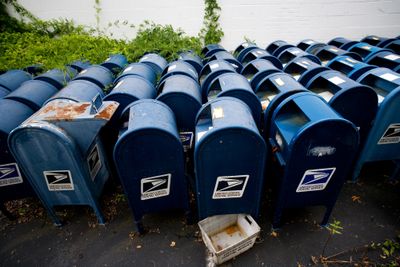Cash-strapped Post Office pulling collection boxes

WASHINGTON – Dorothy and Andrew Yankanich moved into their $18,000 brick rambler in Wheaton, Md., in 1966 and soon began what would become a daily ritual: Walking across the street to the squat blue mailbox and dropping off bills, birthday cards, letters, catalogue orders and whatever else needed to be sent on its way. For 43 years, in rain and shine, through the raising of seven children, the friendly box they could see through their front window was always there.
Until, one day at lunchtime a week or so ago, it wasn’t. Yankanich, 82, watched as postal workers hacked at the rusted bolts and hauled the box away for good.
Across the country, stalwart blue “collection boxes” like the one on Flack Street in Wheaton are disappearing. In the past 20 years, 200,000 mailboxes have vanished from city streets, rural routes and suburban neighborhoods – more than the 175,000 that remain. In the Washington area alone, half the blue boxes that were on the streets nine years ago have been pulled up, leaving 4,071 mailboxes remaining in the District of Columbia, Northern Virginia and the Maryland suburbs.
“It was a nice-looking box,” sighed Dorothy Yankanich, 77, looking out on the empty concrete slab across the street. “That was my exercise. Going across the street with the mail every day.”
The vanishing boxes are only the most visible sign that something fundamental is changing in the way Americans communicate. The boxes are disappearing because most of us, unlike the Yankaniches, no longer use the mail as we used to.
The U.S. Postal Service says it removes “underperforming” mailboxes – those that collect fewer than 25 pieces of mail a day – after a weeklong “density test.” Snail mail is a dying enterprise because Americans increasingly pay bills online, send e-vites for parties and text or give a quick call on a cell phone rather than write a letter.
Combine the impact of new technologies with the gut punch of the recession, and in the past year alone, the Postal Service has seen the single largest drop-off in mail volume in its 234-year history.
The situation is so dire that the Postal Service, which is projecting a $6 billion shortfall by the end of September despite a recent postage rate increase, will go to Congress this month to seek emergency relief, looking to cut home mail delivery from six days a week to five. Already, the Postal Service has cut hours at hundreds of post offices across the country. It has consolidated routes, offered workers early retirement and imposed hiring and salary freezes. Still, said Postmaster General John E. Potter, the service is in “acute financial crisis.”
“We’re like air,” said Postal Service spokeswoman Deborah Yackley. “People just take it for granted that we’re always going to be there. Well, if you want to keep your collection box, would you mail a letter, please!”
The Postal Service is valiantly trying to keep up with the times. Customers can buy stamps at grocery stores or online; the system’s Web site lets users print out mailing labels and order boxes that the Postal Service will pick up at your door and ship for one price, regardless of weight. “We want people to say, ‘Hey, I can turn my home into a post office,’ ” said Bob Bernstock, president of mailing and shipping services at the Postal Service. “We need to evolve because the way people are communicating has evolved.”